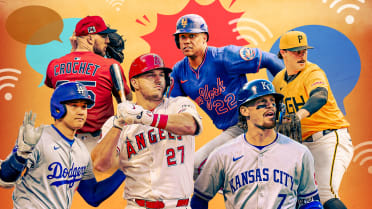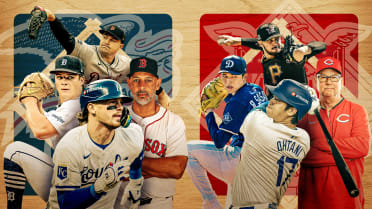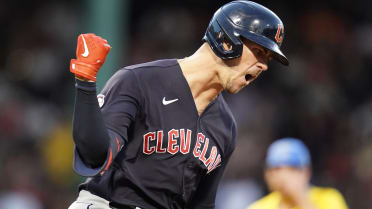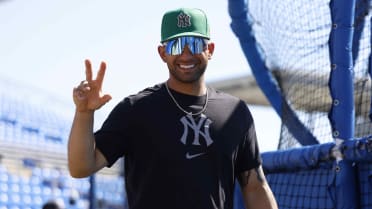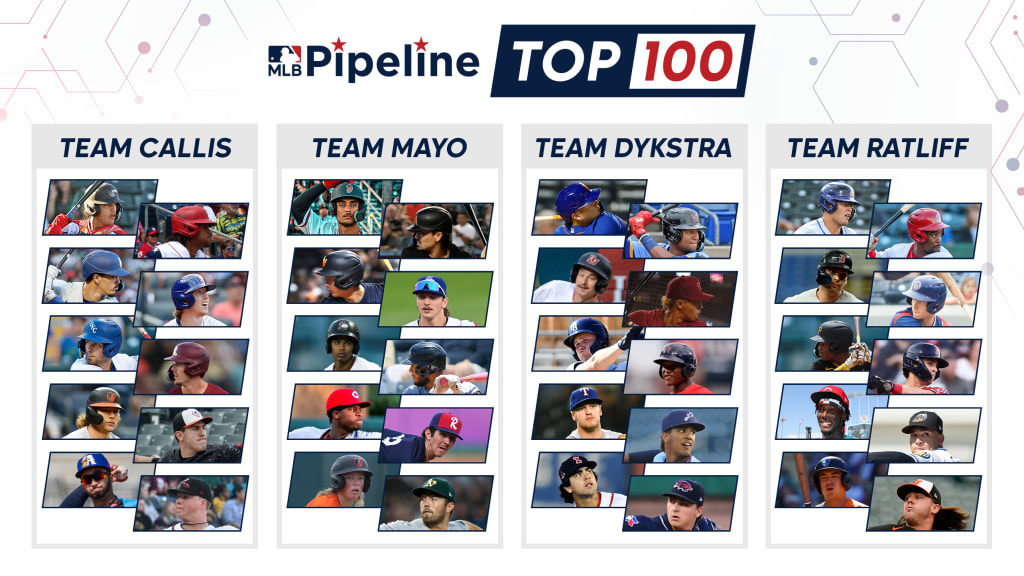
When we put together our prospects lists every year, we try to rank players based on what they will do in the big leagues in the future. Projection is the name of the game.
This year’s Top 100 list is no exception, where once again we tried to look into the proverbial crystal ball to forecast who will be the best Major Leaguers.
On this week’s MLB Pipeline Podcast, we got to try to pick our favorites. In a 10-round Draft, Jim Callis, Sam Dykstra, Jonathan Mayo and Jason Ratliff used the Top 100 as a talent pool and picked a player at each position (including three total outfielders, one right-hander and one left-handed pitcher), based on who we think will have the most long-term value.
Sam set an Outlook reminder for Jan. 31, 2033, so we can look back then and see who won the Draft.
Team Callis
1. (1) Gunnar Henderson, 3B/SS, Orioles (No. 1)
2. (8) Diego Cartaya, C, Dodgers (No. 14)
3. (9) Kyle Harrison, LHP, Giants (No. 18)
4. (16) James Wood, OF, Nationals (No. 17)
5. (17) Brett Baty, 3B/OF, Mets (No. 21)
6. (24) Grayson Rodriguez, RHP, Orioles (No. 7)
7. (25) Michael Busch, 2B/OF, Dodgers (No. 54)
8. (32) Jordan Lawlar, SS, D-backs (No. 11)
9. (33) Evan Carter, OF, Rangers (No. 41)
10. (40) Miguel Vargas, 3B/OF/1B, Dodgers (No. 37)
I always try to look at position scarcity with these things, but didn't think there was an obvious No. 1 pick. I thought Termarr Johnson might have the best value relative to his position but didn't want to take him 1-1. I also considered Corbin Carroll because you have to find three outfielders. But ultimately I just decided to take the best player.
I thought the drop-off after the first two catchers was pretty big so that made Cartaya an easy pick. Also thought LHP was thin so I took Harrison, though I knew that would affect me at other positions.
I felt like no one I hoped might slide a little and get to my next pick ever did, as everyone was making good picks throughout. Baty qualifying in the outfield was a nice break. The only break I caught was Sam taking Kyle Manzardo, which meant I could push Vargas to my last pick -- I kind of assumed he'd be my first baseman when this started.
There were plenty of shortstops so I just waited. You guys probably knew I'd take Carter.
Team Mayo
1. (2) Corbin Carroll, OF, D-backs (No. 2)
2. (7) Andrew Painter, RHP, Phillies (No. 6)
3. (10) Jackson Holliday, SS, Orioles (No. 12)
4. (15) Tyler Soderstrom, 1B/C, A’s (No. 39)
5. (18) Harry Ford, C, Mariners (No. 52)
6. (23) Ken Waldichuk, LHP, A’s (No. 76)
7. (26) Endy Rodriguez, 2B/C/OF (No. 55)
8. (31) Zac Veen, OF, Rockies (No. 27)
9. (34) Emmanuel Rodriguez, OF, Twins (No. 88)
10. (39) Cam Collier, 3B, Reds (No. 69)
I tried to go for a combination of the top talent and high upside, which led to what might be construed as “reach” picks. I definitely went according to chalk by taking Carroll with the second pick -- it was a good spot to be in because I could just react to whatever Jim did, and taking our No. 2 guy at No. 2 made a ton of sense.
My next two picks were along those lines as well, taking who I thought was the best player in the spot without worrying too much about positional depth. Sure, I could have gotten a very good RHP later on, but I really wanted Painter, and he is our best pitching prospect, so I went for it. After recovering from the shock of Jim not taking Holliday with his back-to-back picks, I couldn’t resist taking the guy he keeps saying will be the No. 1 prospect in baseball a year from now.
I started taking care of some of those scarce positions after that. I really like Soderstrom and Manzardo at 1B, and even though I have been on the Manzardo train for a while, I opted for the higher-ranked guy. I saw a separation in lefties between Waldichuk, who I think is a definite starter, and DL Hall, who could end up in the bullpen, which is why I took the A’s southpaw there. I didn’t take the highest-ranked catcher on the board because I really believe in Ford, and have said (on the Pipeline Podcast previously) that I think the Mariners’ athletic backstop will be our No. 1 catcher a year from now. Then I took advantage of some positional flexibility to fill my second base spot with Endy Rodriguez, who I think is really going to hit. I may have reached a bit for Emmanuel Rodriguez (I cornered the market on E. Rodriguezes) and Collier, but when the former is a top 20 prospect and the latter is atop the third baseman list, I’m going to look smart.
Team Dykstra
1. (3) Francisco Álvarez, C, Mets (No. 3)
2. (6) Jackson Chourio, OF, Brewers (No. 8)
3. (11) Ricky Tiedemann, LHP, Blue Jays (No. 32)
4. (14) Druw Jones, OF, D-backs (No. 14)
5. (19) Kyle Manzardo, 1B, Rays (No. 73)
6. (22) Curtis Mead, 2B/3B, Rays (No. 33)
7. (27) Eury Pérez, RHP, Marlins (No. 13)
8. (30) Marcelo Mayer, SS, Red Sox (No. 9)
9. (35) Josh Jung, 3B, Rangers (No. 34)
10. (38) Elijah Green, OF, Nationals (No. 46)
I joked on the podcast that I intended to use a drafting strategy (think NASCAR) in that I would wait on my fellow pickers to select a player from a top-heavy position and then snatch a prospect I thought was close soon after. That’s how Tiedemann and Manzardo -- two prospects I like a lot -- ended up being relatively high picks compared to their Top 100 status because I wanted to pounce before featuring a rough drop-off on the left-hander and first-base lists.
That said, I did aim for high-ceiling types where I could and was elated with my outfield of Chourio, Jones and Green. Some hit-tool questions may keep all three from reaching their full potential, but would it be a shock if the trio made up a starting NL All-Star outfield some day? Not really.
Since this is about long-term value, I’m less worried about Álvarez’s defensive concerns for now and am leaning into his 70-grade power potential. I would have been happy with anyone from our Top 4 shortstops so I waited, but Mayer gives me a nice balance of hit and glove along similar lines to Chourio and Jones. Bring on the next decade.
Team Ratliff
1. (4) Jordan Walker, OF/3B, Cardinals (No. 4)
2. (5) Termarr Johnson, 2B, Pirates (No. 26)
3. (12) Elly De La Cruz, SS/3B, Reds (No. 10)
4. (13) Triston Casas, 1B, Red Sox (No. 23)
5. (20) Pete Crow-Armstrong, OF, Cubs (No. 28)
6. (21) Sal Frelick, OF, Brewers (No. 30)
7. (28) Anthony Volpe, SS, Yankees (No. 5)
8. (29) Daniel Espino, RHP, Guardians (No. 16)
9. (36) Kevin Parada, C, Mets (No. 36)
10. (37) DL Hall, LHP, Orioles (No. 97)
Going into the Draft, I planned to wait on RHP and SS because there were four of each within the top 16 players overall, and I knew I’d be happy with whichever one I got.
With the first three picks going off the board in order, I took the best player available, Walker, who also had the benefit of being eligible as an outfielder and third baseman, which afforded me some flexibility moving forward. I then made the biggest reach down the Top 100 among the top 10 picks, taking Johnson, who I thought was possibly the best value in the Draft based on position scarcity. Jim even considered him at 1-1.
With my third pick, I took perhaps the most exciting prospect in baseball, De La Cruz, who has giant upside and provided additional position flexibility. I then nabbed the top-ranked first-base prospect, Casas, giving me the best prospect at each position on the right side of the diamond. I used my next two picks on outfielders, skipping over the higher-ranked Veen to get 80-grade fielder Crow-Armstrong and 70-grade hitter Frelick.
With four picks remaining, the other three teams had filled their C, RHP and LHP spots, so knowing that I could wait on those positions, and with two other teams still needing a shortstop, I grabbed Volpe, the highest-ranked shortstop on the Top 100 and No. 5 overall. Not bad for the 28th pick.
I got the No. 16 overall prospect, Espino, with the 29th pick and the No. 36 prospect, Parada, at No. 36. After the top two left-handers went with the ninth and 11th picks, I was content to take whichever of the two remaining southpaws was left for me, so I wound up with Hall as my final pick.
